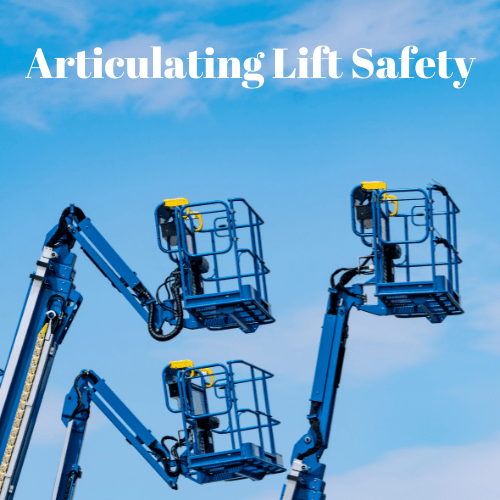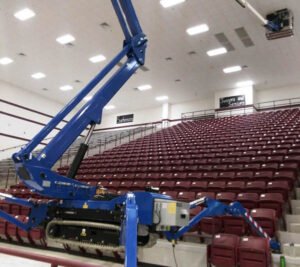Articulating lifts, known as atrium lifts or spider lifts, are extremely useful machines that provide access to many work areas that are too high or difficult to reach by other means.
These articulating lifts allow you to reach work areas in extreme locations. Because they can reach as much as 100 feet high and forty-five feet out, they demand special attention to safety during their operation.
This is underlined by the fact that as many as 26 construction workers die each year while using aerial lifts. These fatalities are most commonly caused by falls, electrocutions, and collapses or tip-overs of the aerial lifts.
Workers in all categories are subject to the risks involved with articulating lifts, including carpenters, electricians, painters, and construction workers.
To ensure your articulating lift use avoids such statistics, the following eight tips will give you the safety edge.
1. Never Lean or Sit at the Edge of the Aerial Lift Work Platform
While it may be tempting to lean and reach for something just out of reach, it’s always safer to lower the lift and reach over instead of climbing and sitting on the guardrail. Guardrails on the work platform are designed to prevent accidents from falling and should never be used to climb or sit on.
2. Ensure lift operators are properly trained and certified
Maintaining relevant safety credentials and knowledge, as well as properly trained employees who can operate aerial lifts, will keep you and your other employees safe. Articulating lifts have safety interlocks and features that should never be overridden and proper training will fully acquaint workers with these safety features. Art
3. Inspect the surrounding work area for any hazards.
The work zone has just as much importance as the machinery. When working indoors, you should examine the ceiling to confirm it’s an adequate height and if there are any potential hazards overhead. You should also inspect the ground and surrounding area for unstable surfaces, bumps, and other potential hazards.
When working outside, check the surroundings for drop-offs, ponds, ditches, slopes, and
debris that should be removed or avoided. If possible, avoid working near overhead electrical lines and communication cables. High winds and severe weather conditions are major hazards to watch out for that can tip over or otherwise endanger your employees.
4. Don’t exceed the specified weight and reach limits
Each model of articulating lift is designed with specific weight, height, and reach limits. It is important to know and adhere to these limits. Going over the limit, even slightly, could potentially cause the lift to topple over. Ensure that you are not exceeding the lift’s recommended capacity before operating the articulating aerial lift. Ensure you take into account the weight of the operator as well as any tools and materials on the work platform.
5. Operate on level ground
Having an articulating lift that extended to its maximum height increases the risks of tipping over. It is imperative the lift is operated on flat, stable ground and using its brakes correctly.
6. Moving the lift correctly
It is vital to know the manufacturer’s instructions on moving an articulating lift when it is extended. The outriggers that provide stability when extended cannot be released without creating a potentially dangerous situation. The lift should be lowered completely, moved, and then repositioned with outriggers extended as necessary.
7. Use outriggers, brakes, and wheel chocks at all times.
The outriggers and brakes are essential for safe operation. Brakes and wheel chocks help prevent the lift from shifting unexpectedly. The outriggers and brakes should be used even if the ground appears stable on the surface. The wheels chocks on your lift are essential for ensuring it stays in place when working on an incline.
8. Don’t use scaffolding on articulating aerial lift platforms
The risk of falling increases greatly when scaffolding is added to a platform or bucket. Regardless of whether the scaffolding falls under the capacity limits, you should avoid doing this.
The shape, potential height and reach, and types of tasks performed make articulating lifts especially needful of full safety precautions Never take shortcuts or forget that the extreme vertical extension and mobility of these machines carry special benefits but also create special risks.


